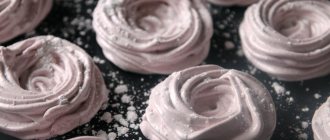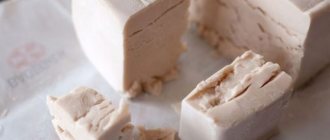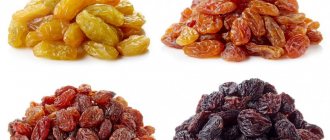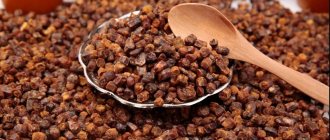Home / Products / Confectionery and sweets / Chocolate
Why do you need to know the expiration date of chocolate? Everyone should now have this useful habit of studying the expiration dates of products before consuming them. But alas, not everyone is interested in this, and some simply do not care.
So why do you need to know the expiration date of the chocolate bar you buy? It's simple - ordinary expired tiles can cause severe poisoning with the most unpredictable consequences.
We’ll talk about the shelf life of chocolate in this article.
Types and methods of preparation
Chocolate can be dark, milk, white, and may contain all sorts of additives. The difference lies in the recipe and cooking methods.
- Dark – contains crushed beans, cocoa butter and powdered sugar. 100% chocolate lacks the last ingredient. This is the reason for its bitter taste, which not everyone likes.
- Dairy - consists of dry cream or milk, as well as cocoa powder and sugars.
- White – contains cocoa butter, powdered sugar, milk powder and vanillin. There are no cocoa beans in it.
- Porous chocolate. It can be dark, white and milky, the difference lies in the method of preparation. It is placed in a vacuum, which creates bubbles.
- Chocolate bar. It may contain beans, but it does not contain cocoa butter. Soy components and vegetable fats are added as a replacement. The product has little in common with real chocolate and is intended for decorating confectionery products.
- With fillings. Nuts, coke shavings, raisins, caramel, and dried fruits are added to the delicacy.
Terms and Definitions
chocolate
A confectionery product made from cocoa products and sugar, containing at least 35% of the total dry residue of cocoa products, including at least 18% cocoa butter and at least 14% of the dry fat-free residue of cocoa products.
milk chocolate
A confectionery product produced on the basis of cocoa products, sugar, milk and (or) products of its processing, which contains at least 25% of the total dry residue of cocoa products, at least 2.5% of the dry non-fat residue of cocoa products, at least 12% milk solids and (or) milk products, at least 2.5% milk fat and at least 25% total fat.
unsweetened chocolate
A confectionery product made from cocoa products that does not contain sugar or sweeteners and contains from 50% to 58% cocoa butter.
bitter chocolate
A confectionery product made from cocoa products and sugar, containing at least 55% of the total solids of cocoa products and at least 33% cocoa butter.
dark chocolate
A confectionery product made from cocoa products and sugar, containing at least 40% of the total solids of cocoa products, including at least 20% cocoa butter.
White chocolate
A confectionery product made from cocoa butter, milk and (or) its processing products and sugar, which contains at least 20% cocoa butter and at least 14% milk solids and (or) its processing products, including less than 3.5% milk fat.
porous chocolate
A confectionery product made on the basis of cocoa products, with or without the addition of sugar, milk and (or) products of its processing, having a cellular structure.
Aerated chocolate includes chocolate, milk chocolate, unsweetened chocolate, dark chocolate, dark chocolate, white chocolate and (or) combinations thereof.
chocolate with large additions
A confectionery product made on the basis of cocoa products, with or without the addition of sugar, milk and (or) products of its processing, containing large additions in the form of whole or crushed food ingredients.
Chocolate with large additions includes chocolate, milk chocolate, unsweetened chocolate, dark chocolate, dark chocolate, white chocolate and/or combinations thereof.
Large additions include whole or crushed nuts, peanuts, candied fruits, raisins, coconut flakes, waffle crumbs, puffed cereals and other food ingredients.
finely ground chocolate
A confectionery product made from cocoa products, with or without the addition of sugar, milk and (or) its processing products, containing finely ground additives.
Chocolate with finely ground additions includes chocolate, milk chocolate, unsweetened chocolate, dark chocolate, dark chocolate, white chocolate and (or) combinations thereof.
Finely ground additives include dried dairy products and/or grated kernels of nuts, peanuts and other food ingredients.
chocolate with filling
A confectionery product that contains at least 40% of the separated chocolate component from the total mass of the product and no more than 60% of the filling.
The separated component of chocolate includes chocolate, milk chocolate, unsweetened chocolate, dark chocolate, dark chocolate, white chocolate and (or) combinations thereof.
chocolate product
A confectionery product that contains from 25% to 40% of the separated chocolate component of the total mass of the product or at least 9% of the total solids of cocoa products, including at least 4.5% cocoa butter.
The separated component of chocolate includes chocolate, milk chocolate, unsweetened chocolate, dark chocolate, dark chocolate, white chocolate and (or) combinations thereof.
The chocolate product is a single product.
Shelf life of chocolate products
Typically, manufacturers carefully pack the delicacy in foil and a branded wrapper on which the expiration dates of the chocolate are written. However, they are not always indicated honestly, and some stores distort the numbers on the packaging. In addition, sweets made from it are not always sold quickly and therefore lie on the shelves for a long time. The shelf life of the product depends on:
- type of product and percentage of cocoa;
- presence of filling;
- fat content
When buying chocolate products, do not be lazy to check with the seller the date of their production and terms of sale.
Deadlines
SANPIN says that the time during which pathogenic bacteria do not form on the surface of desserts ranges from 30 days to a year.
These standards apply to tiles of any origin: be it Russian or Swiss.
What determines the guaranteed shelf life? The value of this indicator is determined by a number of factors:
- amount of fat and cocoa powder;
- presence of flavoring additives;
- production conditions;
- storage conditions (temperature from +2 to +32, humidity from 30% to 93%).
Let's remember! A product with a wrapper is stored longer than without it. So, homemade delicacies have a freshness retention period of no more than 30 days.
Let's consider how long the most popular bars and bars should take before consumption:
- Twix, Snickers, Bounty, mars - 7 months, Nesquik - 6-9;
- Milka - 1 year (according to GOST, this type of confectionery product can be stored for no more than six months, probably the time is increased due to the preservatives in the composition);
- Alpen gold, Kinder chocolate eggs - 9-12 months (depending on the composition);
- classic “Alenka” tiles – six months;
- Babaevsky Firm, Babaevsky Elite, Inspiration classic, Spartak, Gold - 1 year;
- Karl phaser, callebaut - one and a half years;
- Karl, ritter sport, Russia generous soul, Nestle, Dove - six months to a year;
- Belgian callebaut - one and a half years;
- Instant powder for making hot chocolate - 2 years;
Products with nuts or with the addition of cookies should be stored less than classic ones. By using preservatives, manufacturers significantly extend this period of time. For example, Ritter sport with marzipan can remain good for a whole year.
After opening the package, it is best to consume the dessert within 24-48 hours. Do not store it completely open: it has the ability to absorb odors.
Lactic
Milk bars can be stored for 10 months if they do not have any flavoring additives (nuts, dried fruits, raisins, cheese, etc.). Otherwise, the time of safe use is reduced to six months.
White
This delicacy can be consumed without harm to health for 30 days from the date of manufacture. This is due to the presence of dairy derivatives in the composition.
Bitter
Bitter bars have the longest shelf life among their competitors, due to their high cocoa content and lack of additives.
With additives
A delicacy with dry additives retains its freshness for 180 days, but with a filling such as fudge, it is half as much - 90.
Candies
Their shelf life depends on the raw materials from which they are made and the presence of filling:
- The record holder among them is dark chocolate candies - 1-2 years;
- dark chocolate product - 1 year;
- from dairy - from six months to a year;
- glazed - 120 days;
- assorted assortments in a box and white chocolate candies - 60 and 30 days, respectively;
- with praline filling - 2 months.
Let's look at the most popular brands:
- Alpen gold, Korkunov, Mars - 9 months;
- French kiss - 90 days;
- Candies “Teddy bear” from the “Red October” factory, chocolate-covered strawberries, Martian - 6-7 months;
- Lind - 1 year;
- Mercy - up to 12 months, subject to the necessary conditions;
- The shelf life of natural truffle is 14 days.
In order to find out the production date and storage conditions of candies sold by weight, you must request a quality certificate from the seller (do not forget to check the batch number).
The shelf life of handmade sweets is much shorter due to the absence of factory packaging and preservatives. For example, a delicacy with the addition of chiboust cream is stored for no more than 2 days, with ganache cream - no more than 7 days, with the addition of liqueur - six months.
Chocolate based products
The shelf life of such products depends entirely on the type of raw materials used and the presence of various additives. Let's look at some of them:
- marshmallows in chocolate - up to 3 months. (for example, marshmallows from the famous Charmel brand retain their beneficial properties for only 60 days due to the complete absence of preservatives);
- the mousse is stored for only 24 hours due to the presence of perishable ingredients in it: milk, butter, etc.;
- pasta - 1 year;
- Shelf life of glazed cheese curds is maximum 15 days. How to treat cottage cheese products.
Rules for storing chocolate
To prevent the taste from spoiling, it is usually recommended to store chocolate in packaging foil. If the sweet dessert was not eaten immediately, it should be carefully packaged. The delicacy does not like direct sunlight, oxygen or high humidity. In addition, the product tends to absorb foreign odors.
Therefore, at home it should be kept away from herbs, spices and other strong-smelling substances. On the other hand, if you put it near cinnamon or vanilla pods, the delicacy will acquire a pleasant aroma.
How to properly store chocolate so it doesn't spoil? It is recommended to keep the sweet product in a cool and dark place; it is not necessary to put it in the refrigerator. After thawing, frozen tiles become covered with a whitish coating, which somewhat impairs the taste.
To preserve chocolate for as long as possible, it is important to comply with the following conditions:
- The air temperature should not exceed 20 degrees, otherwise the chocolate will begin to melt. In this case, droplets of oil are visible on the surface, and the tile itself acquires an unpleasant odor.
- Humidity – up to 70%. Excess water causes mold to appear.
- Once the package is opened, the chocolate should be eaten within 5 days.
- During the hot season, storage in the refrigerator is allowed.
There is one secret. If you put a chocolate bar in the freezer and keep it at a temperature of -18°, the delicacy will be stored without loss of quality for 2-3 years. However, re-freezing the product is not allowed.
The chocolate bar has expired, can I still use it?
If you find expired chocolate on the shelf, do not rush to throw it away. Before eating, taste it, smell it, and evaluate its appearance. If nothing suspicious is found, the bar can be eaten as soon as possible. If the chocolate has expired, it can be melted and later used for icing.
Do chocolates and sweets have an expiration date?
Of course there is.
Chocolate, candy and other similar products belong to the category of food products, so a priori they cannot be indefinite. What is the expiration date? This definition is disclosed in paragraph 4 of Art. 5 of the “Law on Protection of Consumer Rights”. It is stated here that the expiration date is mandatory for:
- food;
- perfumes and cosmetics;
- household chemicals and similar products;
- medicines.
Based on this article, the expiration date is the period of time established by the manufacturer, after which the product is considered unsuitable for its intended use.
Download for viewing and printing:
Article 5 of the Law of the Russian Federation dated 02/07/1992 No. 2300-1 “Rights and obligations of the manufacturer (performer, seller) in the field of establishing the service life, shelf life of the product (work), as well as the warranty period for the product (work)”
How to recognize safe chocolate
The safe product consists exclusively of cocoa beans, butter, sugar and dry milk ingredients. As additives, it may contain soy lecithin, vanilla, and natural spices. This chocolate can be stored for quite a long time.
If the composition contains sugar, milk, and a cocoa butter substitute in the first place, you are not dealing with real chocolate, but with a chocolate bar. The sweetness will have a waxy taste, it is better not to buy it.
Another sign of a quality product is the price. All the ingredients are not cheap, so it is impossible to buy real chocolate for pennies.
You can recognize a safe product by the following signs:
- crunching while breaking;
- matte surface in fracture areas;
- no bubbles if the chocolate is not porous;
- melts on the tongue.
When purchasing, pay attention to the presence of natural additives, the place of manufacture and the addition of harmful synthetic impurities.
How does composition affect preservation?
chocolate
If you carefully read on the packaging what the chocolate is made of, you will see the name “cocoa mass.” It is obtained from cocoa fruits (beans). And then, as a result of complex technological influence, oil and powder are separated from the cocoa mass. It is the taste of butter that a person feels when a chocolate piece “melts” in the mouth.
There are three main types of chocolate, and each of them can be enjoyed for a certain time. Let's look at how long chocolate can be stored and how it depends on the cocoa content in it:
- Black - has the lowest content of cocoa butter and the highest content of cocoa liquor. Therefore, it has the longest shelf life - 12 months.
- Dairy - more butter and less cocoa are used for production. It can be stored for no more than 10 months if the composition does not contain any additions or fillings.
- White has the highest content of cocoa butter, and there is no cocoa liquor at all. Shelf life - no more than a month.
As you can see, it all depends on the oil content in the chocolate.
Do you know that…
After cocoa butter reacts with air to oxidize, the taste of the bar changes and begins to taste bitter.
New to the market is ruby chocolate, named for its pink color. It contains no dyes and has a berry flavor.
Chocolates
Confectioners surprise consumers with the variety of products they produce. But:
- Additions to the composition reduce the shelf life of chocolates to 4 months, and assorted chocolates delight in taste for only 2 months. These time frames apply to products manufactured at the factory.
- If chocolate and chocolate candies were made at home, then after 72 hours you can no longer eat them.
Manufacturers understand that antioxidants increase the time it takes to consume dessert. Therefore, they are included in the product. Knowing this, you need to carefully study the inscription on the label. Give preference to those products that are manufactured according to GOST rather than according to TU.
Do you know that…
The time it takes to consume the delicacy will be reduced if you choose a filling with a high oil content and a liquid consistency.
Expiration dates of popular brands of chocolate
You should trust well-known brands. Their products are in demand, and the manufacturer is unlikely to spoil their reputation. The shelf life of popular types of chocolate differs:
- Alpen gold – the composition includes fillings, but the manufacturer has increased the shelf life from 9 to 12 months;
- Milky way - delicate milk chocolate, but the shelf life has been extended to 12 months;
- “Alenka” - nothing is added to the dairy product, so the consumption time is 6 months;
- “Babaevsky” chocolate – stored for 12 months.
Signs of the end of the shelf life of goodies
You should not eat chocolate if it has a bitter aftertaste, smells like rancid oil, or smells like mold. Is it possible to be poisoned by chocolate if its organoleptic properties change? Yes, that's why such tiles need to be disposed of.
Another danger that awaits expired chocolate is the larvae of food moths. Although they will not cause significant harm to health, eating such a “delicacy” is extremely unpleasant.
The signs of depravity are as follows:
- have holes on the surface;
- taste of old fat;
- musty smell:
- bitter and “plasticine” taste.
How to understand that the expiration date has expired?
Information on the product label will help you understand that chocolate is expired . A spoiled treat can be recognized by the following signs:
- sour, rancid, astringent taste;
- stale, stale smell;
- too weak cocoa aroma.
Attention!
Chocolate moths pose a serious health hazard. Before eating dessert, break the bar. If small grains of feces, larvae or “tunnels” are visible, do not eat the product.
Is it possible to eat expired chocolate?
Natural chocolate without additives can be eaten even after the expiration date. However, you won’t be able to get the same pleasure as from a fresh product. A chocolate dessert with an expiration date does not taste as delicious as a fresh product.
Carefully examine the appearance of the treat, the presence or absence of mold, mucus on its surface, and third-party odors. Bitterness and a suspicious appearance indicate that the product is completely spoiled and may cause symptoms of poisoning.
Best before date
There are small white dots visible on the old tiles. This means that the expiration date expires and the chocolate dries out. The duration of storage depends on factors:
- type of chocolate product;
- dates of manufacture;
- the presence of artificial additives and preservatives in it;
- ambient temperature and humidity;
- packaging tightness.
Storage rules
Storing chocolate at home should be carried out according to the rules.
- Bitter is the most durable product. The shelf life of chocolate is 12 months.
- Dark, with a smaller proportion of cocoa - chocolate can be stored for 6 months.
- Dairy - no more than 6 months, since it contains a perishable product - milk powder. In the presence of stabilizers, the shelf life of tiles increases.
- White chocolate must be sold within 1 month. Since it does not contain cocoa powder, which itself is a preservative, the product spoils quickly.
- With additives. This dessert can be kept in the buffet for 3 months.
- Chocolate bars are the most short-lived product and should be consumed within 2 weeks.
What is chocolate afraid of and in what conditions does it feel comfortable?
How to properly store chocolate? Sweets should be hidden away from sunlight. Under the influence of light and oxygen, chocolate oxidizes, and its taste properties change. The best place to store treats is on a shelf in a closet at room temperature. It must be kept in an airtight container, preferably in foil. If you bought a chocolate bar by weight, put it in a cardboard container and hide it away in the cupboard.
Chocolate is afraid of the following factors:
- sunlight;
- oxygen;
- heat;
- low temperatures;
- high humidity.
Why you can store chocolate in the refrigerator, but it is not advisable
In summer, when the temperature in the room is above 20 degrees, the sweet bar should be put in the refrigerator. It should be kept on the bottom shelf or on the door at a temperature of 2 degrees. If you put already melted sweetness in a cold place, a whitish coating appears on its surface. It does not cause harm to health, but noticeably worsens taste.
Products from popular manufacturers
The time during which the delicacy does not lose its consumer qualities is determined individually by each manufacturer.
Here are the expiration dates stated by well-known brands:
- "Alpen Gold" - from 9 to 12 months, the specific shelf life depends on the type of chocolate. This manufacturer is known for supplying the market with tiles with various original additives, and they are known to significantly reduce shelf life;
- “Alenka” - this chocolate can be stored for 6 months; as a rule, its composition does not contain additives or oxidizing agents;
- Milka chocolate can be stored for up to 12 months, although according to GOST such a product must be consumed within six months after production. The shelf life in this case is also increased due to the presence of oxidizing agents that prevent the product from spoiling;
- Babaevsky chocolate , according to the information provided on the packaging, can be stored for 12 months after the date of its manufacture.
How long does chocolate actually last?
Although manufacturers hide it, natural bitter, dark and milk chocolate is stored for another 6 months after the expiration date. It contains a lot of beans, which extend its shelf life and act as preservatives. It is most dangerous to consume expired white chocolate because it does not contain cocoa powder.
This also applies to tiles with fillings. Fruits, wafer crumbs, and nuts have their own shelf life limits. When buying sweets with additives, be guided by the shelf life indicated on the packaging.
Expiration dates according to GOST
The current GOST R31721-2012 does not establish exact shelf life for chocolate. Clause 3 of Part 8 states that the shelf life of products depends on the recipe or technical instructions for the products of a particular manufacturer.
The Soviet state standard 6534-89, now invalid, established the following storage periods depending on the type of chocolate product:
- for white chocolate - 1 month;
- for a product without packaging containing additives – 2 months;
- for packaged with additives - 3 months;
- for unpackaged without additives - 4 months;
- for chocolate in original packaging, containing no additives – 6 months.
Currently, due to changes in the recipe and manufacturing process, the shelf life of chocolate products has increased significantly.
What happens if you eat expired chocolate?
If you consume a spoiled product, there is a high risk of food poisoning. Substances harmful to health are formed inside it, and pathogenic microbes, including fungi and bacteria, multiply. The appearance of microorganisms is not associated with the expired shelf life. Most likely, they were originally in the tile.
There is also information on why expired chocolate is harmful. According to medical data, oxidized fats cause tumor growth. However, few people decide to eat a spoiled product regularly and in large quantities, and eating such a dessert once will not lead to cancer. Let's consider whether it is possible to be poisoned by chocolate, the symptoms of food intoxication.
Signs of food poisoning:
- abdominal pain;
- nausea;
- vomit;
- loose stool;
- weakness;
- temperature increase.
Note! Deterioration in well-being can be caused not only by food poisoning, but also by eating too many treats. The digestive system always copes with the load, which is indicated by a deterioration in well-being.
First aid for poisoning
The person needs to drink plenty of water, do a gastric lavage, and cleanse the intestines. Adsorbents (Polysorb, Enterosgel) and enzymatic preparations are prescribed. However, if you feel worse, you should seek medical help.
What determines the shelf life of chocolate products?
All food products are provided with information about the expiration date of the product, including chocolate sweets. It is impossible to store them indefinitely, and safe use depends on many factors:
- fat and cocoa powder content;
- the presence of filling or filler in the form of nuts, dried berries and fruits, waffle or biscuit layer, rice balls;
- manufacturing method - factory or home;
- presence or absence of packaging;
- storage conditions: temperature, humidity, light.
Next, we will analyze all these factors in more detail.
Storage conditions and shelf life of confectionery products
Most confectionery products include sugar or its substitutes (honey, sorbitol and other sweeteners); as well as fruit and berry fillings, molasses, vegetable oil, butter and dairy products, cocoa, nuts, flour and other ingredients. Despite the wide variety of confectionery products, they can be divided into two main groups:
- sugary products, which include products that do not contain flour: candies, chocolate, caramel, marshmallows, halva, marmalade, etc.;
- flour products, including cakes, cookies, rolls, gingerbreads, pastries, muffins, etc. Confectionery products of both groups contain a whole range of substances important for the human body: fats, proteins, carbohydrates, mineral elements, vitamins. Thanks to modern technologies for the production of confectionery products, it has become possible to increase the biological value of products, preserve vitamins, protein, and active enzymes. It is very important for the consumer to preserve the nutritional value of the product, for which purpose special refrigeration equipment is used during transportation, storage and sale of confectionery products: confectionery display cabinets, refrigerated slides.
Despite the wide and varied range of products, technological features of production and quality of raw materials, the shelf life of confectionery products depends mainly on one predominant factor. Eg:
- In one case: chocolates, bars and cookies differ significantly in the production method, and the factor influencing the guaranteed shelf life of these products is the structure of the lipid complex.
- In another case: with completely different manufacturing technologies for gingerbread, marshmallows, and fudge, the main factor determining shelf life is considered to be desorption, which causes drying (hardening) of the products during storage.
- Maintaining the proper quality of such various products as waffles and caramel depends on a common indicator - absorption, the ability to absorb moisture from the outside.
What are the possibilities for increasing the guaranteed shelf life of confectionery products? In the first case, changes in the structure of the lipid complex primarily depend on the oxidative capacity of fats.
Different degrees of oxidation (light or deep) cause changes in organoleptic and physicochemical parameters: from deterioration of smell and taste (food rancidity of fats) to the formation of harmful, toxic substances.
To minimize the effect of factors causing fat oxidation, synthetic and natural antioxidants are used that oxidize faster than fats.
The use of fats that contain unsaturated fatty acids, which are the last to undergo the oxidation process, inhibits the oxidation of fats in flour confectionery products. One of the most effective ways to slow down the oxidative reaction of fats is to create certain storage conditions for confectionery products (temperature, humidity) using refrigerated slides or display cases.
Sorption and desorption, which occur during storage of certain types of confectionery products, play a major role in determining the guaranteed shelf life. These processes depend on several factors:
- physical and chemical composition of raw materials;
- indicators of the structure of the finished product;
- air humidity and temperature;
- moisture activity in stored products.
The same product, under different environmental conditions, will either release or absorb (saturate) moisture. For example, caramel at high humidity (more than 80%) will absorb moisture and subsequently become soft and lose its shape. But at the same time, with a humidity of up to 70%, the caramel will eventually lose moisture and become sugary.
When storing cookies without packaging in conditions of high humidity, the cookies will also become saturated with moisture and release it at low humidity. Even with a humidity of 75%, the average moisture content of cookies ranges from 8.5% to 9.5%, although the recipe requirements are 6% - 7%.
Therefore, storing cookies without packaging at a relative humidity of 70% - 75% will lead to gradual moistening and loss of brittleness.
Compliance with the rules for storing confectionery products guarantees not only the preservation of product quality, but also the reduction of commodity losses. The main parameters that determine storage conditions are:
- ambient temperature;
- relative humidity;
- sanitary and hygienic conditions;
- ventilation and lighting of the room.
Proper stacking and arrangement of products in accordance with the requirements of the commodity neighborhood also plays an important role.
The storage temperature of confectionery products has the most significant impact on product safety.
The majority of culinary products should be kept at low temperatures in cool rooms (pantry, utility room), refrigerated cabinets, and confectionery display cases.
Sudden changes in temperature negatively affect the quality of confectionery products, while a violation of the temperature regime activates physical and chemical processes, promotes the appearance of condensation on the surface of the product, and reduces its sales period.
In addition to temperature, relative air humidity is of great importance during storage. Exceeding this indicator can cause the development of microorganisms and mold.
It is also mandatory to ensure natural or forced ventilation of premises where confectionery products are stored.
Ventilation helps maintain the required temperature and humidity by removing gas and steam.
It should be noted that when choosing refrigeration equipment for storing confectionery products, you need to pay attention to the type of cooling.
There are confectionery display cases with static cooling, in which the cold air emanating from the evaporator is distributed naturally inside the display case, and display cases with dynamic cooling, where the circulation of cold air is carried out using a fan.
The latter type of cooling allows you to reach the required air temperature inside the display case much faster and maintain it without significant changes (no more than 2°C - 4°C). However, the dynamic type of cooling has its drawbacks, in particular, chapping of some types of culinary products.
This is especially true when storing flour confectionery products without packaging (cakes, pastries, muffins, rolls). When placing products in pantries or refrigeration equipment, it is necessary to adhere to the rules for the proximity of goods and the timing of their sale.
Products must be placed in groups, on racks, shelves at a distance of at least 0.5 - 0.7 meters from the walls. You cannot store culinary products that have a pronounced odor that can be transferred to other products, and products that have high humidity (jam, fruit products, cream) next to hygroscopic dry products (gingerbreads, waffles, crackers).
- Weight candies in wrappers are stored in bulk in cardboard boxes, unwrapped ones are covered with paper. The maximum weight per package depends on the strength of the candies.
- Dragees are best stored prepackaged in boxes, packs or plastic bags. Prepackaged dragees are packaged in external containers (boxes, crates). Depending on the strength of the dragee, the maximum weight of one package is up to 10 kg (jelly type) and up to 20 kg (caramel type).
- Cakes and cakes are stored in special cardboard or plastic boxes, the bottom of which is lined with paper. It is allowed to store cakes without packaging; in this case, they are stored on wooden trays lined with parchment.
- Cookies, muffins, waffles and other dry flour confectionery products are stored in a cool room (no more than 18°C), with a relative humidity of 70% - 75% (with the exception of butter cookies and waffles, for storage of which the humidity should be 65% - 70 %).
Each batch of products must be labeled indicating the exact time and date of manufacture, as well as the period and storage conditions.
Where and how to properly store chocolate
You should find out why you cannot store chocolate in the refrigerator. Tiles are afraid not so much of cold as of temperature fluctuations. The more often this occurs, the greater the difference in performance, the worse the product. As a result, the tile turns white. As for the correct temperature regime, it should be like this:
- it is better to store sweets at +17...+20 degrees, it is worth considering the humidity, it should not exceed 70%;
- an indicator equal to +30℃ is critical for the delicacy; it will begin to melt, melt and lose its appearance.
The best temperature to store the product without loss of quality is considered to be +18 degrees. A deviation of 3 degrees in one direction or another is acceptable. In the refrigerator the indicator is much lower, from +3 to +6 degrees. In such conditions, water freezes out. As a result, sucrose crystals appear on the tile. The product becomes hard and tastes bland.
Important! Where to store chocolate - the preferred place is a closed cabinet, where moisture and sunlight do not penetrate.
At what temperature should chocolate be stored?
- If the air temperature ranges from 16°C to 21°C, then this chocolate storage temperature is simply ideal.
- It is necessary to take into account, of course, the shelf life, during which it will not deteriorate at all and will not change its taste.
- At what temperature does chocolate melt? It is impossible to answer this question unequivocally, because this is influenced by many factors: the ingredients included in the chocolate, air humidity.
- It is believed that chocolate begins to melt at 30-34°C. If the room is cooler, then it will not thaw - but this, of course, is if the product is of high quality and contains natural cocoa butter, and not a cheap fake with vegetable fats.
Chocolate storage
Food safety of the product. Shelf life and storage conditions of chocolate
Chocolate products are very beneficial for the human body. Chocolate contains many vitamins, microelements, antioxidants and amino acids. These substances allow you to improve performance, mental activity and activate all vital functions.
Chocolates promote the production of so-called happiness hormones - endorphins. In addition, they have the properties of a typical aphrodisiac.
Those who have a tendency to allergies, high blood pressure and excess weight should not indulge in candy. In addition, eating too much chocolate daily (which many women are guilty of) accelerates skin aging.
Having studied the traditional composition of good chocolate, everyone understands that this product cannot retain its original qualities for long. That is why the shelf life of chocolates is limited.
- Dark chocolate candies with solid fillings last the longest; their shelf life can reach six months. This is due to the absence of perishable components. These primarily include milk or cream.
- Dark chocolate candies filled with dried fruits (prunes, dried apricots, etc.) or roasted nuts can be stored for up to 4 months.
- Milk chocolate products with similar fillings remain fresh for up to 3 months.
- Chocolates with protein fillings (soufflé, poultry's milk), with creamy fudge or soft dried fruits (may sour) have a shelf life of no more than 2 months.
- Minimum shelf life for white chocolate products. The lack of cocoa bean powder makes them unsuitable for long-term storage.
The reason for the loss of necessary qualities is the presence of oil, milk and other ingredients that interact with air. Oxidation, mold formation and other unpleasant signs of deterioration occur. It is worth paying attention to expiration dates for two reasons.
- If the expiration date has almost expired, this threatens the loss of the external and taste qualities of the product. A white coating, strange odor, or unexpected bitterness or acidity may appear.
- If candies are expired, this can cause the formation of mold, oil stains on the surface, an unbearable smell and a disgusting taste. You can easily get poisoned with this product.
It is better not to buy loose chocolates, since information about their expiration date (if it is available to the buyer at all) may not correspond to reality.
IMPORTANT Despite the wide range of sweets, the quality of raw materials and different recipes, the shelf life of sweets depends on the creation of optimal storage and sales conditions. Drying or absorption of moisture, changing the structure of the lipid complex of confectionery products, leads to a decrease in the period of time specified by the manufacturer. To maintain high quality products, you must strictly follow the instructions for storage and transportation.
Factors affecting the shelf life of candy:
- physical and chemical composition of products;
- structure of the finished confectionery product;
- humidity, air temperature indicators;
- moisture level in stored products;
- ventilation, room lighting;
- sanitary and hygienic storage conditions.
When purchasing loose goods, you can safely ask the seller for documentation. Any products undergo certification, their compliance with the sold confectionery products is provided to the buyer upon verbal request. Then you need to compare the batch number with the number indicated in the document.
For your information
Often information about the expiration date of candies can be found on the packaging container. It is worth remembering that the shelf life of caramel is from 3 to 6 months, caramel covered with chocolate is no more than 3 months, with milk filling up to 3 months. Lollipops last the longest (up to 6 months), but unscrupulous sellers can sell them for several years.
The manufacturer indicates the shelf life of the candies according to the composition and production technology of the product. There are average standards for various confectionery products; they do not always coincide with factory data.
| Candies | Best before date |
| caramel, lollipops | 6 months |
| iris | 3 years |
| chocolate candies | 1.5-4 months |
| licorice candy | 1 -1.5 years |
| truffles | 6-12 months |
| marzipan | 4- 12 months |
| fondant candies | from 3 days to 4 months |
| praline | 2-4 months |
| fruity | up to 6 months |
| dairy | up to 9 months |
| liqueur | from 3 to 9 months |
| waffle | 6-9 months |
| cream | up to 15 days |
| nutty | from 4 to 8 months |
| jelly | 3-12 months |
| bars | 6-12 months |
| candied fruit | 12 months |
How to deliver chocolate in hot weather?
The only way to prevent chocolate candies or bars from melting in hot weather is to ensure that the chocolate does not melt, that is, place it in a cool place.
- Thermal bag. It will help if you need to transport dessert over a long distance, for example, transporting chocolate in the heat on a train. To be safe, you can place dry ice inside.
- Food thermos. Why exactly like this? It has a wide mouth, making it easy to fit tiles. If the chocolate has an airtight package, you can pour cold water into the thermos.
- The third method is freezing. Place the chocolate in the freezer for a day or two and then wrap it in a towel. This way you can keep it for several hours even in hot weather.
If the above options are not available, it will be more difficult to preserve chocolate in the heat. But what you definitely shouldn’t do is put the tile in your pocket - body heat will cause it to melt even faster, or place it in a dark bag or leave it in direct sunlight. A light bag with a bottle of cool water at the bottom next to the tile will significantly reduce the risk of getting a shapeless chocolate mass together with delicious slices.










